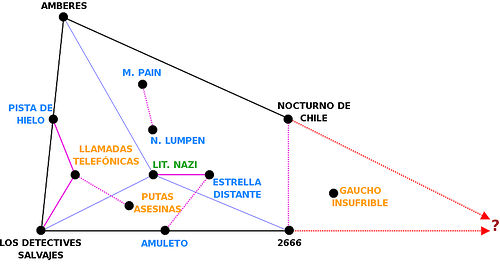Still working through this Roberto Bolaño jag: I will finish By Night in Chile tonight or tomorrow, and I’ll get to my own thoughts on that then. For now: while looking for an interview in English with Bolaño, I came across this marvelous essay in The Quarterly Conversation–a site Biblioklept links to, oddly enough, yet I missed it (probably because it’s a few years old). In “Roberto Bolaño: A Naïve introduction to the geometry of his fictions,” Javier Moreno doesn’t really analyze or criticize or Bolaño’s oeuvre ; instead, he treats the work like a strange, maddening (and fun, beautiful) game. And if you’ve read Bolaño, you know how appropriate that approach is. Here is Moreno’s attempt to diagram Bolaño’s corpus:

That question mark represents what Moreno suggests is Bolaño’s “unreachable book,” a tome that (might) exist as the dialogic interplay of all of Bolaño’s works. Moreno concludes (more or less; concludes is really not the right word) that 2666 is that “unreachable book”; he writes:
I believe that even if Bolaño hadn’t died prematurely 2666 would still have been published posthumously. The “real” and impossible 2666 was larger and richer. My guess is that if Bolaño had lived forever 2666 would have been at the very end of the diagram, located in the vertex where the question mark is. Since he died, since he was mortal (too mortal) after all, we have to resign ourselves to the promise of a triangle and only dream of its asymptotic completion.
Consider this fragment of an interview as evidence for Moreno’s claim:
Amambay Guevara: What’s the novel you dream of writing?
Roberto Bolaño: One novel that will be called 2666.
Ricardo Bello: That novel, 2666, would it be a science fiction one? Would it be located in Latin America?
Roberto Bolaño: Partially, it will be science fiction. It will take place in the state of Sonora, north of México, and in Arizona.
I think Moreno’s essay is pretty great–it’s the sort of writing I like, and its tone is spot on for the psychology and rhythm of Bolaño’s writing. Still, I think you’d probably go crazy thinking about what’s at the end of that triangle, of some great work out there, intangible, unfinished, unclaimed, disparate. In the end, Moreno gives up on his diagram, writing:
The system doesn’t stay still. That’s the way it is. Conscious of the impossible task, I resign. I cannot capture it. I cannot shoot the video. The dots are moving as I stare at them, still puzzled, marveled by their strangeness and beauty. The diagram, after all, is just a waste of time.
I like the way his line about moving dots subtly recalls the strange ending of The Savage Detectives. Also, I’m not sure that the diagram is a waste of time. I think that what Moreno might not see (or shit, maybe he does see it, how would I know) in his own diagram is that that question mark might not be some unwritten masterpiece, but rather it might be the reader who enters into the game with Bolaño and his texts. The irony is that that is precisely what Moreno has done. And–sign of a great critic–he’s made me want to read more.

It’s unfortunate that the whole essay isn’t available online, but this article from the Believer is the best in english that I have read thus far: http://www.believermag.com/issues/200703/?read=article_fresan
Maybe you are a subscriber or have another way of reading it. Maybe you don’t. Either way, I’m happy to see another Bolaño addict emerge.
LikeLike
ps. Have you seen this on the Savage Detectives?
http://literateneroids.blogspot.com/2009/06/savage-detectives-roberto-bolano.html
LikeLike
yeah, i actually have that issue, castro, in fact it was my introduction to bolaño, although at the time i was a bit mystified. i pulled it out and started to reread it. i’m glad you reminded me about it, too, because around the same time they ran a piece of w.g. sebald, and i’d also like to reread that after reading *the rings of saturn* (i wonder if you’ve read sebald; i think if you dig bolaño you’d dig him too).
LikeLike
This is interesting. I’d love to see more of this diagrammatic technique in analyzing other books, especially Pynchon’s “Gravity’s Rainbow”.
LikeLike